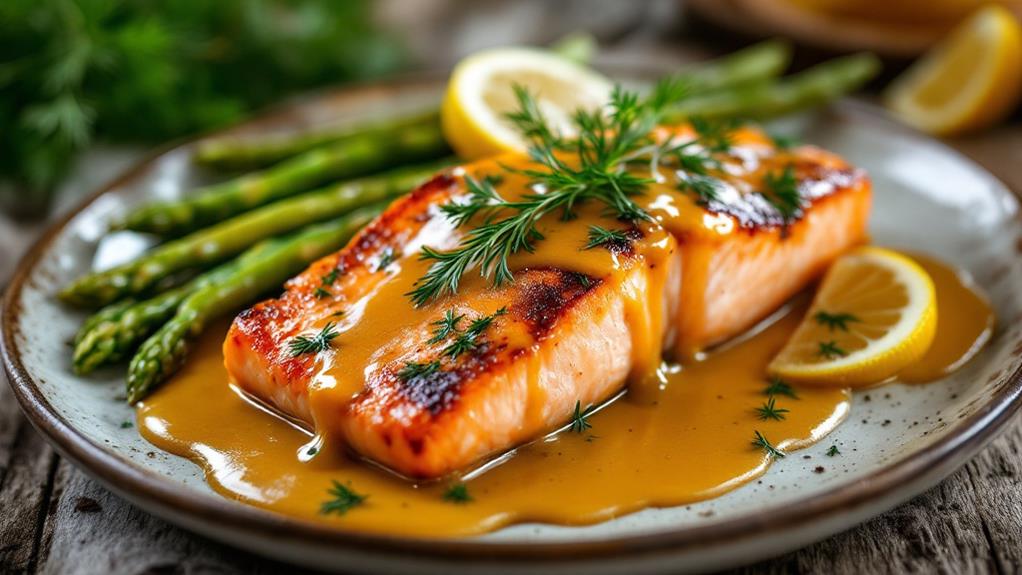It's a coincidence that you stumbled upon this recipe just as salmon season peaks. You might be wondering how to elevate your dinner with a simple yet sophisticated dish that's both nutritious and satisfying. The combination of rich salmon and a creamy Dijon sauce creates a delightful balance of flavors, but there's more to this dish than meets the eye. As you consider the nuances of preparation and pairing, you'll find that the right touches can transform a standard meal into something truly special. What elements will you explore to enhance this culinary experience?
Key Takeaways
- Use high-quality wild-caught salmon fillets for optimal flavor and health benefits, rich in omega-3 fatty acids.
- Prepare a creamy Dijon sauce by whisking Dijon mustard, heavy cream, and lemon juice over low heat for a velvety texture.
- Cook salmon skin-side down in a preheated non-stick skillet, aiming for an internal temperature of 145°F for perfect doneness.
- Serve salmon garnished with fresh herbs, lemon juice, and colorful seasonal vegetables for an appealing presentation.
- Experiment with different herbs and sauces to customize the flavor profile of the salmon dish.
Ingredients Needed
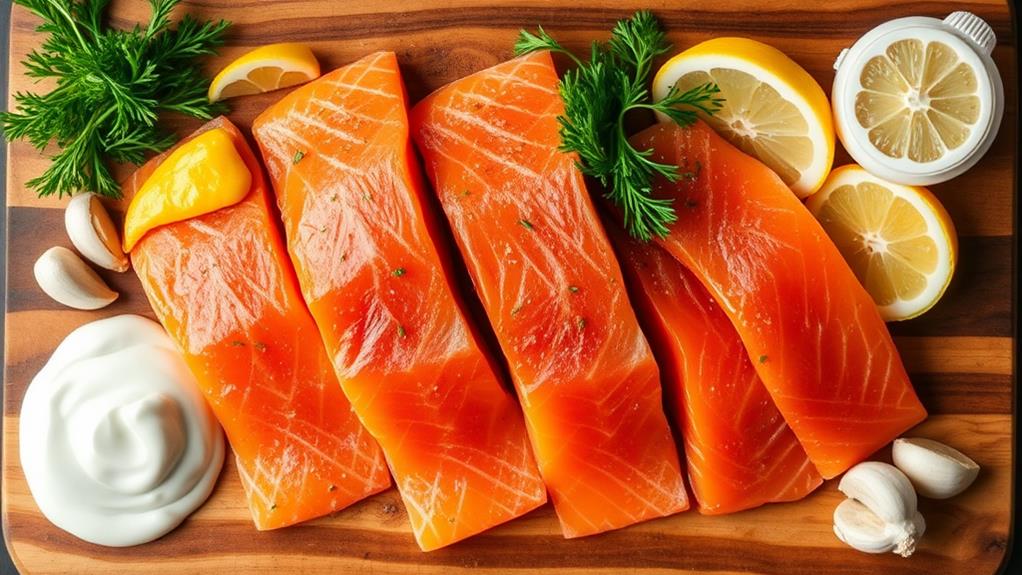
To whip up this delicious Salmon with Creamy Dijon Sauce, you'll need a selection of fresh ingredients that bring the dish to life. Start with high-quality salmon fillets, ideally wild-caught, as they're not only tastier but packed with omega-3 fatty acids that offer numerous health benefits, including reduced inflammation and improved heart health.
Next, gather some fresh herbs like dill or parsley to add an aromatic touch. You'll also need Dijon mustard, which gives that creamy sauce its signature tang. Don't forget heavy cream for richness and a splash of lemon juice to brighten the flavors.
On the side, consider sautéing seasonal vegetables like asparagus or spinach, which complement the dish beautifully and provide additional vitamins and minerals.
For cooking techniques, you can pan-sear the salmon to achieve a crispy skin, then finish it off in the oven to ensure even cooking. This method locks in moisture while keeping the fish flaky and tender.
With these ingredients and techniques, you're well on your way to creating a stunning meal that's not only delicious but also nourishing. Enjoy the cooking process and savor the delightful results!
Preparing the Salmon
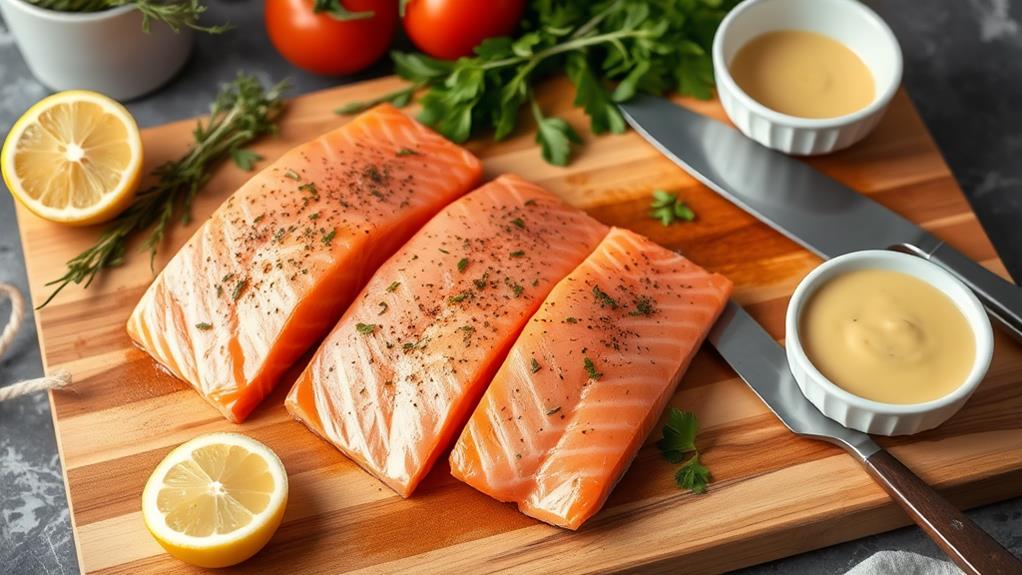
With your ingredients ready, it's time to prepare the salmon for cooking. Begin by selecting the freshest salmon you can find; its vibrant color and firm texture are key indicators of quality. Rinse the salmon fillets gently under cold water, patting them dry with a paper towel. This step helps ensure the seasoning adheres well and enhances the overall flavor.
Next, let's talk about seasoning options. You can keep it simple with just salt and pepper, allowing the natural flavors of the salmon to shine through. Alternatively, consider adding a sprinkle of garlic powder, paprika, or fresh herbs like dill or parsley for an extra layer of taste. If you're feeling adventurous, a squeeze of lemon juice will brighten the dish beautifully.
Once seasoned, heat a non-stick skillet over medium-high heat and add a drizzle of olive oil. When the oil shimmers, carefully place the salmon in the pan, skin-side down if applicable. This method helps achieve a deliciously crispy skin.
Cook for about 4–5 minutes on each side, depending on the thickness of the fillets, until they're cooked to your liking. Enjoy the delightful aroma as the salmon sizzles!
Making the Creamy Dijon Sauce
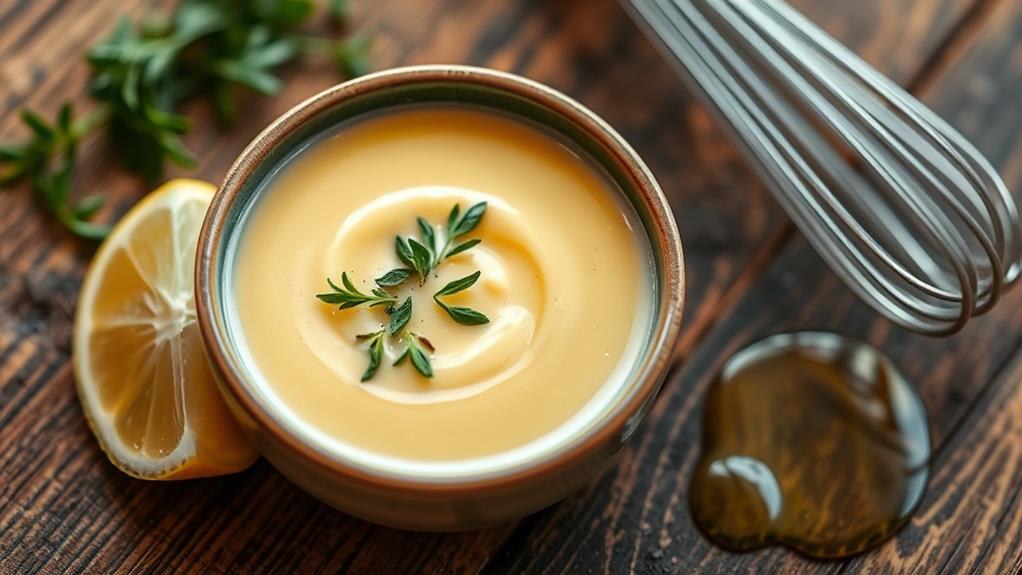
Creating the creamy Dijon sauce is a simple yet rewarding process that elevates your salmon dish to new heights. Start by gathering your ingredients: Dijon mustard, heavy cream, lemon juice, and a pinch of salt and pepper.
In a medium saucepan over low heat, whisk together a tablespoon of Dijon mustard with a cup of heavy cream. This combination will create a rich, velvety base for your sauce.
As you mix, pay attention to the sauce consistency. You want it to be smooth and creamy, not too thick or too runny. If it feels too thick, add a splash of water or more cream to achieve that perfect texture.
Next, stir in a squeeze of fresh lemon juice; it brightens the flavor and enhances the overall flavor balance. Taste your sauce and adjust with salt and pepper as needed.
Once everything's well combined and heated through, remove it from the heat. Your creamy Dijon sauce is now ready to drizzle over the salmon, adding a luxurious touch that complements the fish beautifully.
Enjoy the burst of flavors that come together in this delightful sauce!
Cooking the Salmon
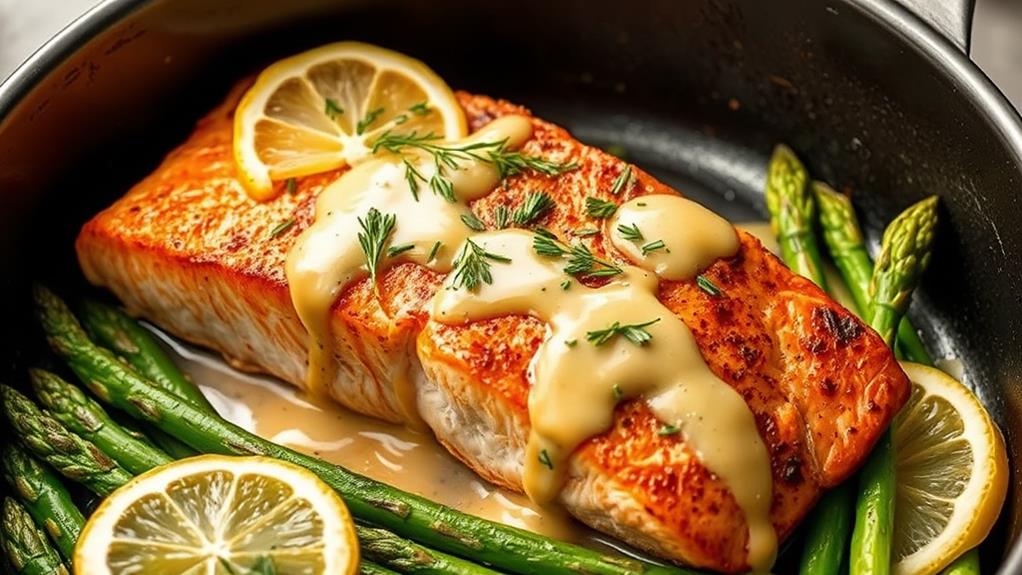
Cooking the salmon is a straightforward yet essential step that brings your dish to life. To ensure you achieve that restaurant-quality flavor, focus on the salmon's freshness and employ the right cooking techniques.
Whether you choose to grill, bake, pan-sear, or broil, the key is to maintain that delicate balance between cooking it just enough while keeping it moist and tender.
Here are a few tips to elevate your salmon cooking experience:
- Choose fresh salmon: Look for vibrant color and a mild scent.
- Preheat your cooking surface: Ensure your grill or skillet is hot before adding the salmon for a perfect sear.
- Use a light touch: Avoid flipping the salmon too soon; let it develop a golden crust.
- Check for doneness: Aim for an internal temperature of 145°F, or when the flesh flakes easily with a fork.
Serving Suggestions
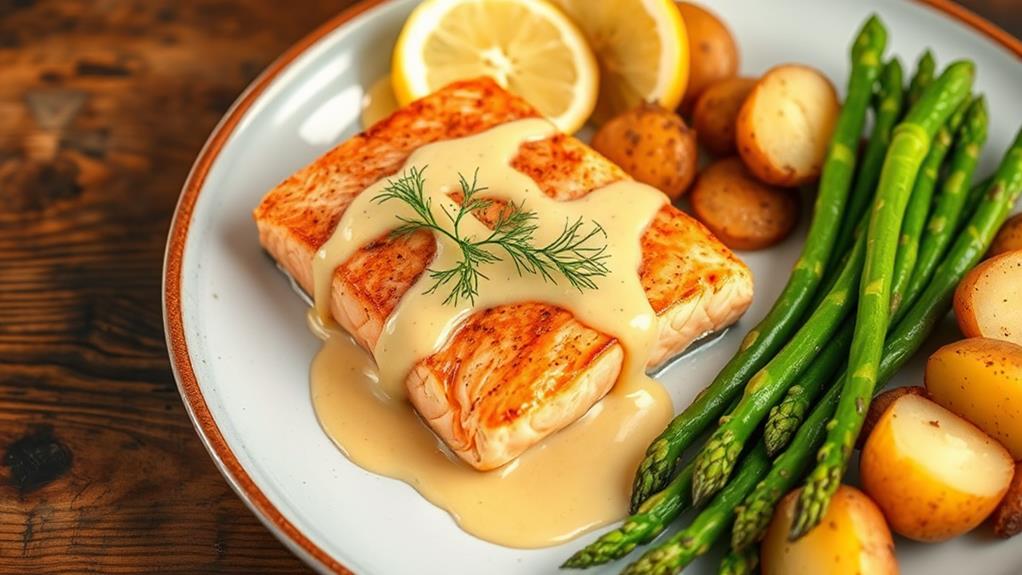
To truly elevate your salmon dish, consider the presentation and pairing of flavors that complement its rich, buttery taste. A well-plated meal not only tantalizes the taste buds but also pleases the eyes. Here are some presentation ideas and flavor enhancements to consider:
| Presentation Ideas | Flavor Enhancements |
|---|---|
| Serve on a warm plate | Drizzle with lemon juice |
| Garnish with fresh herbs | Add capers for zest |
| Use colorful vegetables | Top with a sprinkle of dill |
| Arrange with citrus slices | Pair with a hint of garlic |
When plating, try to create height and texture. Layer your salmon on a bed of sautéed greens or quinoa for added dimension. A bright garnish, like parsley or chives, can draw attention to the dish while enhancing the overall flavor profile. Consider a light drizzle of olive oil or a balsamic reduction for that extra touch. Each of these elements not only beautifies your plate but also heightens the enjoyment of your salmon with creamy Dijon sauce, making every bite a delicious experience.
Pairing With Side Dishes
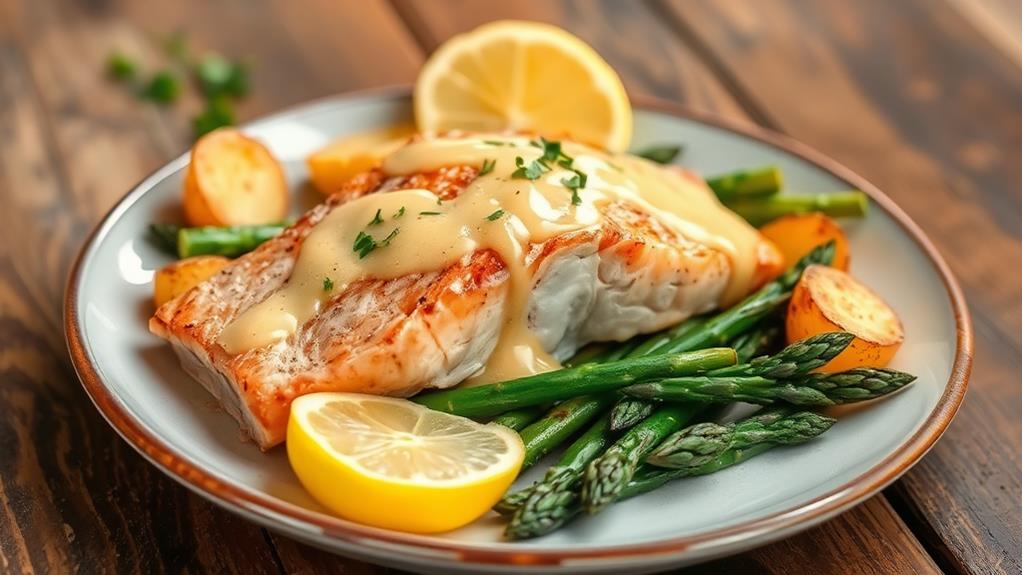
A delightful plate of salmon with creamy Dijon sauce deserves equally enticing side dishes to create a balanced meal.
When selecting your sides, think about how they'll complement the salmon's rich flavor and the sauce's tangy notes. You want to create harmony through flavor profiles and introduce texture contrasts for an enjoyable dining experience.
Here are some fantastic side dish ideas:
- Garlic Roasted Asparagus: The crispness of asparagus adds a fresh crunch that pairs well with the creamy sauce.
- Lemon Quinoa Salad: The zesty, light flavors of this salad enhance the salmon while providing a fluffy texture contrast.
- Sautéed Spinach with Pine Nuts: This dish brings a nutty crunch and earthy notes, balancing the richness of the salmon.
- Creamy Mashed Potatoes: The smooth, buttery texture of mashed potatoes makes for a comforting side that complements the dish beautifully.
Tips for Perfect Salmon
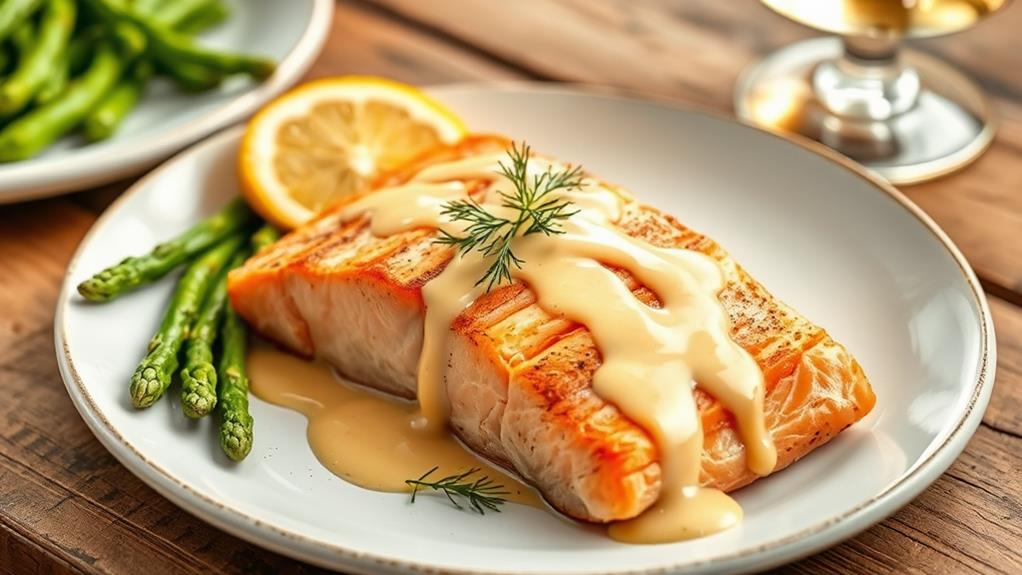
Perfectly cooked salmon is a delightful centerpiece that can elevate any meal, and achieving that ideal texture and flavor takes a bit of finesse. Start by selecting high-quality salmon; fresh, wild-caught varieties often boast richer flavor profiles. Before cooking, let the salmon come to room temperature for about 15 minutes—this helps it cook evenly.
When it comes to cooking techniques, you have several options. Pan-searing gives the fish a beautiful crust, while baking ensures a moist interior. If you prefer grilling, make sure to oil the grates to prevent sticking.
Remember, cooking time varies based on thickness; generally, aim for about 4-6 minutes per half-inch of thickness.
Don't forget about seasoning! A sprinkle of salt and pepper goes a long way, but you can enhance the dish further with herbs or citrus. For added flavor, consider marinating the salmon for 30 minutes before cooking.
Once done, the salmon should flake easily with a fork and have a tender, juicy texture. With these tips in mind, you're well on your way to mastering the art of cooking salmon!
Variations of the Recipe
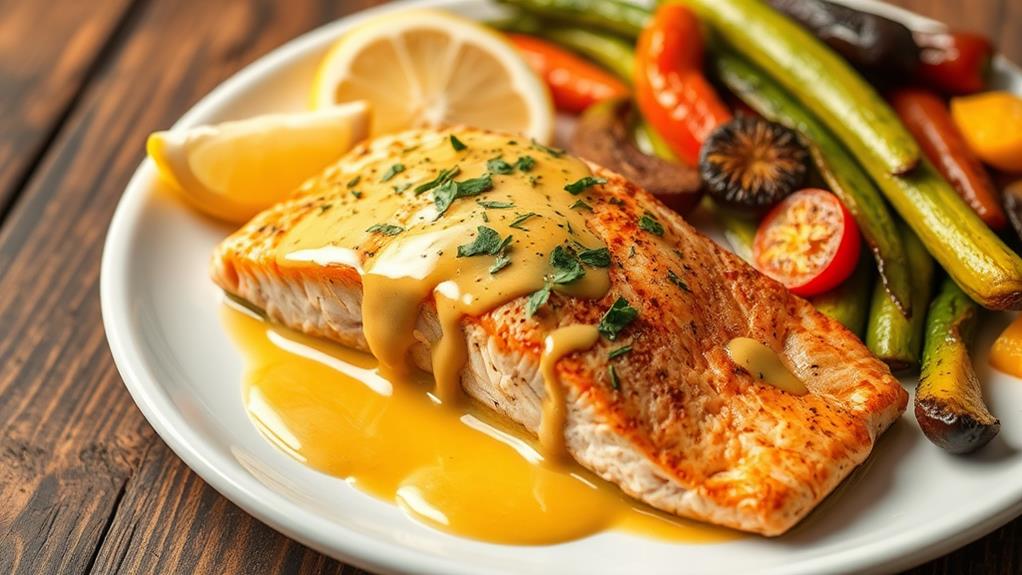
Once you've mastered the basics of cooking salmon, exploring variations of the recipe can introduce exciting flavors and textures to your meals.
Experimenting with herb variations and sauce alternatives not only elevates your dish but also keeps your palate delighted. Here are some ideas to inspire your next culinary adventure:
- Herb Variations: Try dill, tarragon, or basil for a fresh twist. Each herb brings its unique aroma and taste that complements the salmon beautifully.
- Lemon-Caper Sauce: Swap the creamy Dijon sauce for a zesty lemon-caper blend that brightens the dish and adds a tangy kick.
- Honey-Mustard Glaze: Combine honey with your Dijon mustard for a sweet and savory glaze that caramelizes beautifully during cooking.
- Spicy Sriracha Sauce: If you're craving heat, mix Sriracha with Greek yogurt for a creamy, spicy alternative that adds a bold flavor profile.
These variations not only transform the dish but also keep it interesting, ensuring you'll never get bored with salmon again.
Embrace your creativity in the kitchen, and don't hesitate to mix and match these ideas!
Storing Leftovers
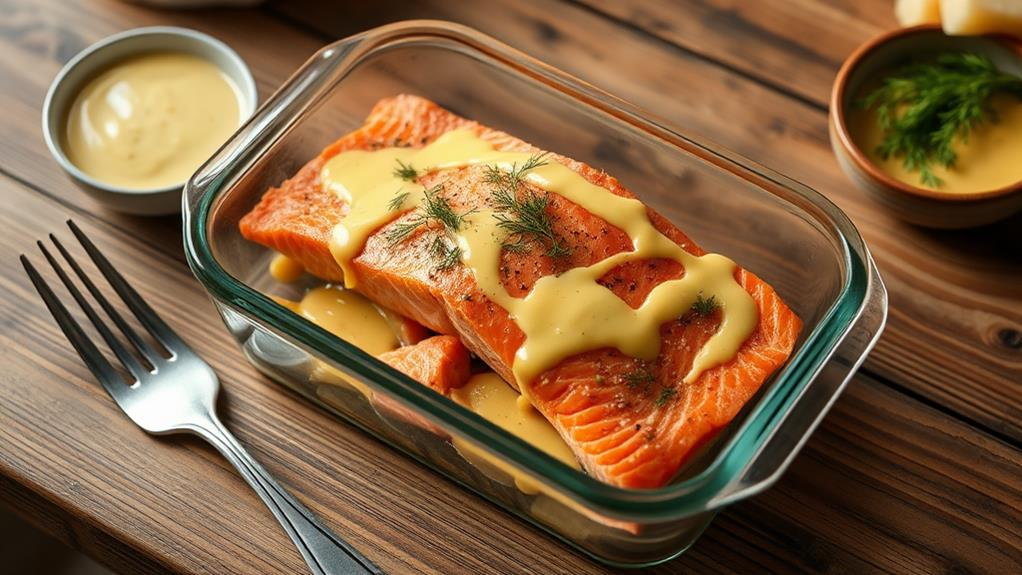
Storing leftovers can be a game changer in your meal planning, allowing you to enjoy that delicious salmon with creamy Dijon sauce again. To ensure your leftovers stay fresh and flavorful, start by letting the salmon cool down to room temperature before storing.
Place it in an airtight container to minimize exposure to air, which can lead to drying out.
In terms of leftover storage, make sure to consume your salmon within three days for the best taste and safety. If you want to keep it longer, consider freezing it. Just wrap the salmon tightly in plastic wrap or aluminum foil, then place it in a freezer-safe bag. This method can preserve its quality for up to three months.
When you're ready to enjoy your meal again, reheating salmon can be done easily. For the best results, use a microwave or oven. If using a microwave, cover the salmon with a damp paper towel to retain moisture.
In the oven, reheat at a low temperature to prevent overcooking. With these simple steps, you'll savor the delightful flavors of your creamy Dijon salmon long after the initial meal!
Frequently Asked Questions
Can I Use Frozen Salmon for This Recipe?
Absolutely, you can use frozen salmon! Thawing it in the fridge overnight is best, but a quick method is placing it under cold water. Frozen salmon's benefits include convenience and freshness, making meal prep a breeze!
What Are Some Alternative Sauces to Use?
If you're exploring sauce variations, consider a zesty lemon-butter sauce for brightness, a rich garlic cream for depth, or a tangy teriyaki glaze for sweetness. Each option brings distinct flavor profiles, enhancing your dish beautifully.
How Long Does This Dish Take to Prepare?
You'll find that preparing this delightful dish takes about 15 minutes of prep time and another 20 minutes to cook. Keep these cooking tips in mind, and you'll create a meal that dazzles!
Can I Grill the Salmon Instead of Baking?
Absolutely, you can grill the salmon! Just use effective grilling techniques and choose a flavorful salmon marinade to enhance its taste. Grilling adds a delicious smokiness, making your dish even more enjoyable. Enjoy the process!
Is This Recipe Suitable for Meal Prep?
Yes, this recipe's great for meal prep! You'll enjoy meal prep benefits like saving time and money. Just store it in airtight containers in the fridge, and it'll stay fresh for up to three days.
